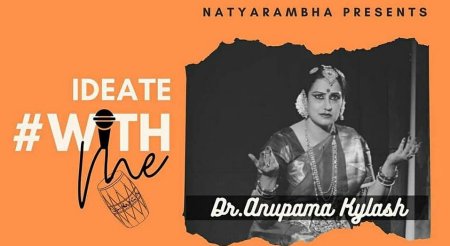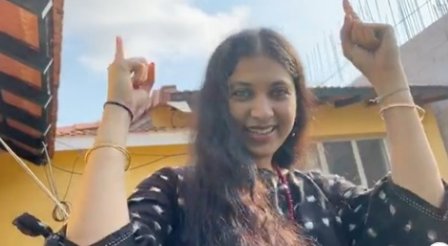
|   |

|   |
 e-mail: leelakaverivenkat@gmail.com Dance distorted during pandemic May 12, 2020 We are now living in a world of the internet where all manner of teacher/taught relationships have gone for a toss- not excluding the performing arts. A sea change indeed for the dance world we have loved to proudly tout as 'classical', where at one time, the Guru/shishya interaction was through 'Gurukula Vaasam' - considered the sine quo non for learning! The constant physical proximity of living in the home of the Guru (nothing less) paved the way for the student unconsciously imbibing the intricacies and totality of a tradition covering aspects not discussed in the formal classroom training. All Gurus, this writer has spoken to, are unanimous that the live classroom with the throb of the students' response is the most effective adrenalin driving the Guru's teaching enthusiasm and with such responses as an aspect largely to be imagined on internet teaching, the task is made more exacting. Unlike music classes on Skype which have been in practice for some time, dance which involves the moving body seems to pose more problems. Says Aruna Mohanty, the Odissi dancer/teacher, "I am constantly itching to pat and straighten a slightly hunched spine, lift a sagging shoulder or correct a body slant in the wrong direction - while constantly realising that in this virtual proximity physical contact is impossible." She has now taken to making diagrams of the right body posture, the way knees are to be placed, and even the line that the hand movement traces in space. "My pictures show the starting position, the middle position and finally the concluding point showing exactly how the hand should move." One of the male dancer/teachers said while talking to me, "The problem is that the camera sometimes creates an optical illusion and distortion, which can result in your correcting what in effect is a correct posture!" Continuing, he said, "Even in abhinaya teaching where minute facial expressions lost in a classroom, can be pinpointed and corrected by the guru, I find the time lag very disconcerting when I am singing and asking the student to perform - for when I have finished singing 'Enneramum' and gone on to the word 'undan sannidiyil...' I find the student still expressing 'Enneramum'." The slight time lag in the internet switchover from teacher to student, would seem to make 'laya' a particularly tricky area- specially with our rhythmic approach which considers the unit of a tala cycle with its immaculate measurement of time in the intervals between beats sacrosanct, while executing a composition. Prerana Shrimali, the Kathak professional said, "How does one teach 'tatkar' or 'peir ka kaam'? By the time my tala beat or recitation of padhant reaches the student, there is that fractional time gap which makes nonsense of all footwork rhythmic virtuosity - so much a part of Kathak." It is a question of getting used to this medium and discovering its secrets to get the best out of it. Let us not forget that in many foreign countries like the United States, teaching Bharatanatyam across cities using the internet is quite common. And while I do not have sufficient experience of the results, in classical music, for youngsters to be tutored on the Skype, has been an accepted practice and from all accounts, some of the shishyas learning under master gurus are a credit to their teacher. For students who have been trained for some time and who are familiar with the art form, internet can provide some beneficial extra coaching. But I have heard teachers say that with new students, distance teaching does not provide the best of results. Nevertheless, at a time like the present, the over-riding factor of connectivity for preserving some cardinal points of the art form, and the opportunity for some invaluable recap, particularly for all those for whom the dance practice is confined to the formal classes (and this is a sizeable percentage), makes the internet communication with the teacher a godsend. While these classes serve to sustain teachers whose livelihood depends solely on teaching, what is really sad is to see those providing the performance- enabling services like light, sound etc left rudderless in the present situation.  Anupama Kylash  Yehi tera time hai Instead of the present scramble for shows on the internet that dancers are seeking, which shows a kind of insecurity that being away from the visible platform will make dancers fade away from memory, why not use this period for some quiet reflection and that silence for which the contemporary way of life seems to have no space? This can be the time when one learns to learn, to acquire soft skills and engage in some critical thinking on aspects the normal classroom instruction has no time for, and some deep introspection on various aspects of the art form can take place in quietude. The discerning ability of one would evolve by listening to lectures. Some like the Natyarambha series arranged by Shankarananda Kalakshetra of Hyderabad, where Anupama Kylash in 'Ideate with me' took up a Ninda Stuti to "tease, cajole and simultaneously eulogise" the divine - and the sub-text derived from the poetry, provided a most informative evening. Also refreshing was the video programme by students of Ananda Shankar, who in "Yehi tera time hai" with Ananda's help, with film director Mani Shankar and music composed by Krupa Ravi Nithyesh, and Ananda's direction, over three weeks produced a short simple work which, not just kept the dancers' minds engaged, but more importantly , looked at how movement dealt by the camera is quite different from how it looks to the audience in a live stage performance. This is an aspect which our classical dancers have not bothered about (barring some work by television), not really exploring how a work should be choreographed to be treated on film. I remember in the early eighties as a petrified interviewer talking to the legendary western dance expert Merce Cunningham who explained how he had been made to stand behind the camera lens and look at what had been set for the live performance. "I was horrified at how distorted it looked", he remarked. From then on he began to choreograph a production differently for filming. Many dancers who think straightforward margam performances on the internet will keep the viewer engaged, are being over optimistic - for without that live experience produced by an interplay of poetry, music, instruments, nattuvangam and movement spurring one another and in turn being inspired by the other disciplines, the internet performance falls flat. So it is high time that dancers tried to understand how to treat movement for the camera. Anything produced for internet has to be professionally done with filmmaker, dancer and musician working together. Such productions would provide space for the light and sound technicians too. Making these special productions available for viewing on payment is another factor altogether.  Writing on the dance scene for the last forty years, Leela Venkataraman's incisive comments on performances of all dance forms, participation in dance discussions both in India and abroad, and as a regular contributor to Hindu Friday Review, journals like Sruti and Nartanam, makes her voice respected for its balanced critiquing. She is the author of several books like Indian Classical dance: Tradition in Transition, Classical Dance in India and Indian Classical dance: The Renaissance and Beyond. Post your comments Please provide your name and email id when you use the Anonymous profile in the blog to post a comment. All appropriate comments posted with name and email id in the blog will also be featured in the site. |